Whatever the position they took on slavery, whites in the South and the North were directly affected by the passage of the Compromise of 1850, the body of legislation that included a much more stringent Fugitive Slave Act. Southerners holding African Americans in bondage felt more secure with a mandate that required the forcible seizure and return of slaves who had fled North. Northerners, now required to assist in the pursuit of slaves, found themselves more deeply implicated in what Stowe would label the "patriarchal institution." Compliance with the Fugitive Slave Act constituted support of slavery, defiance made an individual subject to fines and imprisonment. However one responded to the Fugitive Slave Act itself, it became less and less tenable to define slavery as a strictly Southern institution. Highly publicized incidents in which fugitive slaves were captured in cities such as Boston and sent South made neutrality about slavery well nigh impossible.
Boston was one of Harriet Beecher Stowe's destinations as she made her way east to settle the family after her husband Calvin had accepted an appointment as the Collins Professor of Theology at Bowdoin College. En route to Brunswick, Maine, during the spring of 1850, Stowe spent a week with each of her siblings, visiting Mary in Hartford, Henry in Brooklyn, and Edward in Boston at the end of the journey. Already committed abolitionists, Edward and his wife Isabella proved instrumental in rallying Stowe. Denouncing the legislation then being debated in Congress, Edward and Isabella did nothing to disguise their revulsion at the prospect of the Fugitive Slave Act. Stowe's initial response recalled her behavior during her earlier exposure to plantation slavery. She listened carefully. She remained silent. After the passage of the Compromise, Isabella decided to write to her sister-in-law. The letter was an impassioned plea. "Hattie," she declared, "if I could use a pen as you can, I would write something that would make this whole nation feel what an accursed thing slavery is." Stowe's children, with whom she shared the letter, recalled Isabella Jones Beecher had succeeded in persuading their mother. Vowing to do what she could on behalf of antislavery, she told them, "I will write something. I will if I live."
It had been more than a decade since Stowe had begun speaking with the gender inflected public voice and moral authority that women of her generation were claiming for themselves. The author of a collection of stories that was issued as The Mayflower in 1843, she had been publishing a story a year in Godey's Lady's Book in the decade before 1850. She had also been contributing regularly to the New-York Evangelist, a weekly dedicated to advancing the millennium at home and abroad. And she was now completing "Earthly Care, a Heavenly Discipline," a pamphlet sponsored by the American Tract Society. Already a maker of public opinion, Stowe was well prepared to make a nation "feel what an accursed thing slavery is." A Beecher, who like her siblings had been harnessed to their father's "chariot of fire," she participated in the social and cultural changes that were transforming the face of antebellum America.
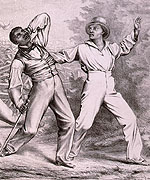
DETAIL: CLICK
IMAGE TO ENLARGE
Stowe was also an actor in one of the most profound changes in gender relations in the course of American history--the influx of white middle-class women into the nation's public life. In their roles as writers, as teachers, as editors, and as reformers, post-Revolutionary and antebellum women entered civil society in astonishing numbers They were there to stay. Thousands of these women had been educated at female academies and seminaries. There they had been taught the same subjects as their counterparts at the exclusively male colleges. Schooling students in the ideals of liberal learning, the principles of logic and moral philosophy, and the arts of rhetoric and composition, academies and seminaries taught women the vocabularies and values of post-Revolutionary and antebellum civic culture. Simultaneously, academies and seminaries provided sites at which students apprenticed for adult roles as makers of public opinion in their communities, in their regions, and, in Stowe's case, in their nation. Students issued newspapers; they published magazines; and they delivered addresses at commencements. The literary societies which they established were additional sites at which they polished their reasoning and rhetorical faculties. At their weekly meetings, students practiced the arts of persuasive self-presentation, presenting commentaries on the books they had chosen and sharing their own prose and poetry. Applying newly acquired knowledge to many of the most contested issues of the day, they debated subjects ranging from the practice of aesthetics to the morality of slavery to the purposes of female education. A student at Sarah Pierce's Litchfield Female Academy and a teacher with her sister Catherine at Hartford Female Seminary and Western Female Institute, Stowe had learned lessons in the making of public opinion long before 1850. Already an established writer, she was well prepared to take on Isabella's challenge.
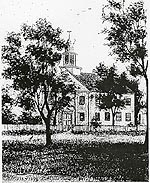
CLICK IMAGE TO ENLARGE

CLICK IMAGE TO ENLARGE
The revolution in women's educational opportunities embodied in the schooling Stowe received had begun in the wake of the other Revolution with which we are more familiar. In the third decade of the nineteenth century, many academies and seminaries began to install a course of study akin to the education Stowe had received at Sarah Pierce's Female Academy in Litchfield, Connecticut. Schooled in a curriculum that Pierce and her nephew John Brace had based on the subjects then being taught at the male colleges, Stowe was expected to command mathematics, moral philosophy, logic, the natural sciences, and Latin. Assigned the same texts as her counterparts attending the male colleges, she read William Paley's Principles of Moral and Political Philosophy, Hugh Blair's Lectures on Rhetoric, and Archibald Alison's Essays on the Nature and Principles of Taste. Pierce's curriculum was gendered in one telling respect. The woman who identified with Hannah More, Maria Edgeworth, and Hester Chapone invited Stowe to read books by and about learned women, inaugurating a tradition that teachers and students practiced at many of the academies and seminaries established in the decades between 1820 and 1860.*
Comparisons of the numbers of students enrolled in these schools show that relative to the male colleges, the female academies and seminaries were educating at least as many students in early nineteenth-century America. The fact that approximately the same number of women and men were enrolled in institutions of higher learning is striking in its own right. It also provides a key to understanding why many women educated at these schools began to press the boundaries that had limited a female's engagement with public life, calling for equal access to the social and cultural domains that had been the preserve of men. "We would have every path laid open to women as freely as to man," as Margaret Fuller asserted in one of the more radical challenges to conventional formulations of gender roles in antebellum America.*
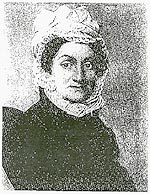
CLICK IMAGE TO ENLARGE
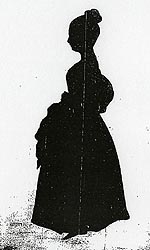
CLICK IMAGE TO ENLARGE
The Revolution that transformed thirteen colonies into an independent nation had been invested with the potential Fuller proclaimed for her contemporaries in 1845. And yet, however they were defined, the possibilities for a transformation in women's status had remained exactly that--possibilities that seemed less and less likely to be fulfilled as the radical impulses unleashed during the Revolution were contained in a newly independent America. In the decades bridging the eighteenth and nineteenth centuries, the boundaries of traditional gender roles were secured against those petitioning for women's political and legal equality. Those who called for an end to the long standing tradition of "educational disadvantaging," as Gerda Lerner has described the practices that denied women access to learning for centuries, had more success in building upon the sense of expansiveness generated by Revolutionary ideology than did those who were asking for political and legal equality. Insisting that learning was both an individual right and a social necessity, they participated in the design of a female ideal, which displayed a variety of faces, all of which were stamped with a gendered republicanism. A formulation of womanhood that I introduced in Learning To Stand and Speak: Women, Education, and Public Life, the concept of gendered republicanism highlights the differences in the rights and obligations of male and female citizenship. A model with an ancestry dating back to the earliest colonial settlements, she might resemble British America's sensible and industrious "good wife," whose most visible characteristic was devotion to her family's spiritual and secular needs. Alternatively, she might bear a closer resemblance to a variation on the "gentleman's companion," the gracious and refined lady who had made her initial appearance in the middle of the eighteenth century. Schooled in the worldly accomplishments of tea table and salon, she was a woman who distinguished herself in the arts of sociability. In varying proportions, all these attributes were visible in the persona of the republican wife who, as an essayist in Boston Weekly Magazine told readers, excelled "as a companion and a helper." And more, so far as moral authority was concerned: in wielding influence on a man's character, she was expected to play a political role of no little significance. The republican wife might also wear the face of an equally influential mother. Taking on the additional responsibility for schooling sons and daughters in the tenets of virtue, she committed herself to preparing children for adult lives as informed and engaged citizens. If this sounds familiar to readers of Stowe, it should. Republican womanhood served as Stowe's point of departure as she crafted the characters she expected readers of her novel to emulate. Perhaps most notably, Mary Byrd, the wife of Senator John Byrd was designed to embody this female ideal.*
The calls for a female education that served an independent America exposed the compromise that was being struck in the decades immediately after the Revolution--a woman's right to educational opportunity was attached to, and made contingent upon, her fulfillment of gendered social and political obligations. No matter if women were acknowledged as the intellectual equals of men, they would still be excluded from the Enlightenment's promise of self-actualization. They would be expected instead to place "the richest of earthly gifts," as one of the Academy's valedictorians characterized the knowledge the Enlightenment honored, at the service of two families, the family they had constituted in taking husbands and bearing children and the family that had been constituted for them in the establishment of an independent United States.*
Some members of the post-Revolutionary elite went beyond the tenets of gendered republicanism to project a more expansive role for themselves in the second of these families, the nation and its civic discourse. Women who were Stowe's predecessors, they acknowledged that a woman's responsibilities centered in her household, but, in a significant revision of republican womanhood's tenets, they extended the reach of female influence to individuals other than the members of one's immediate family. In this newly enlarged constituency these women included individuals involved in the heterosocial world of salons, literary clubs, assemblies, and tea tables. Established by British America's elite in the middle of the eighteenth century, these institutions of sociability were located in cities and towns from Boston to Charleston. The sites at which participants engaged in polite conversation and in performance of belles lettres, salons, literary clubs, assemblies and tea tables were designed as discursive institutions. In enacting the conversational ideal of reciprocal exchange, in reciting poetry, in performing music, and in displaying wit and learning, men and women of privilege grounded the cultivation of sensibility in shared affections, genteel manners, and social pleasures. Their successors displayed the same commitment to the cultivation of sensibility. However, America's post-Revolutionary elite did more than replicate the culture of sociability practiced in the colonies. Revolution and republic, transformation in material and ideological context, all led them to elaborate on established premises and practices.*
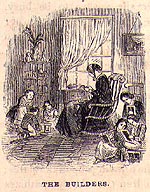
CLICK IMAGE TO ENLARGE
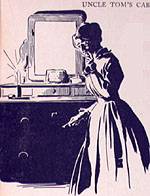
CLICK IMAGE TO ENLARGE
Most notably, in a deliberate refashioning of gender roles, female members of this elite made themselves historical actors in their own right. In the philosophers of the Scottish Enlightenment, they had available a model of gender relations that not only privileged the "affections" as a source of insight but that designated women the protectors of manners and morals. Having been accorded a crucial role in shaping the character and behavior of husbands and sons, these women took the opportunity to empower themselves in all of their relationships with males--not only as wives and mothers, but also as friends and companions. The sites they chose to deploy this expanded influence were the female-centered institutions of tea table and salon and, if in the nation's capital, of presidential levees, capital balls, and informal gatherings. In these discursive institutions they superintended the behavior of men, refining and polishing their manners, enlarging and deepening their sympathies, and aiding in the cultivation of their moral sense. And most important, they used these sites to take the stage as full fledged actors in a role that until now had been played only by men--the making of public opinion.*
In their engagement with the production of public opinion, they signalled the opportunity for a fundamental change in the system of gender relations newly independent Americans had inherited from British America. However, in a historical moment that appeared to be filled with transformative possibilities, forces moving in another direction were defining the private and public, the social and political, the feminine and masculine, as oppositional rather than complementary. Prefigured in the model of the republican wife and mother, an ascendant discourse of domesticity did much to codify the gender distinctions between public and private that elite women had challenged. Increasingly as well, the claims for intellectual equality and educational opportunity that had been made on the basis of women's equal share in the Enlightenment's "reason" were marked by similar codifications. Said to be endowed with a special capacity for the "affections," women's mental capacities were increasingly differentiated from men's. In contrast to men who relied on the "senses," the medium of knowledge privileged by Lockean empirical psychology, women were understood to comprehend, and to act upon, the world through their expressive, or affective, capacities, which were presumed to be a primary source for moral and spiritual insight.
The relatively fluid gender distinctions of the post-Revolutionary decades were increasingly freighted with ideological determinism in antebellum America. Nowhere was this more apparent than in Sarah Josepha Hale's "'Conversazione," the essay with which she launched her career as the editor of the early nineteenth-century's most popular magazine. "We are always at home," Hale reminded readers of Godey's Lady's Book. There and only there women pressed forward with their appointed task--"bless[ing] as well beautify[ing] civil society," as she described their charge in 1837. It had been left to the women of Hale's generation to jettison the non-gendered "reason" upheld by elite women in the post-Revolutionary decades. Hale took to this task with alacrity. Marking the "affections" feminine and the "senses" masculine, she sharply distinguished between women and men according to the manner in which they "awaken[ed] the reason and direct[ed] its power." The "Empire of reason" that the post-Revolutionary generation had claimed the right to inhabit equally with men would no longer be women's only residence. Now they would be expected to preside as well in Hale's "empire of the heart," as she designated their second domicile and the faculty with which they were increasingly identified.*
This gendering of mental capacities shaped the meanings attached to eighteenth-century sympathy and sensibility and its nineteenth-century formulation, sentiment and sentimentality. In contrast to earlier generations who had made sympathetic identification an ideal for men as well as women, Hale coded sensibility as a distinctively female attribute. Similarly, she came close to stripping sensibility of rational reflection, making it a medium of knowledge governed by the "affections" alone. Harriet Beecher Stowe's sister did the same. Indeed, Catherine Beecher anticipated by six years Hale's reordering of the hierarchy of faculty psychology. Basing her argument on the tenets of the Scottish Enlightenment that elite women in post-Revolutionary America had found so useful, Beecher's Suggestions Respecting Improvements in Education, which appeared in 1829, made the "affections" the catalyst for the exercise of "reason and conscience." In the Improvements in Education that Beecher installed at Hartford Female Seminary, she acknowledged to her students that both women and men had to cultivate the "affections." But, as she insisted, women such as themselves had a special purchase on this faculty, having in a proportion more generous than a man's "already received from the hand of her Maker those warm affections." Despite the fact that she had positioned women in the role of men's redeemers, Beecher hastened to tell her students that the reordering she had accomplished would have no impact on women's subordinate status in the gender hierarchy. "Woman," as she stated emphatically, remained "bound to 'honor and obey' those on whom she depends for protection and support."*
More than twenty years later, Stowe imprinted the lessons Catherine Beecher had taught on the pages of Uncle Tom's Cabin. Weaving the threads of domestic discourse into the novel, she represented wives and mothers as the moral and spiritual leaders. Exemplars and inculcators of the values that ought to govern the home and the larger society, Stowe's women were charged with defending the sanctity of the family and reforming the world beyond its doors. Slavery, as Stowe showed her readers, made a mockery of this conception of women's role in every possible dimension. The idealized family could be shattered at a slaveholder's whim. Marriages could be ended at any moment, mothers could be forever separated from their children. White women who might have aided African Americans and their children seemed to be left with little or no recourse. Fulfilling their role as redeemers in an antebellum America that held women and their children hostage appeared well nigh impossible after the passage of the Fugitive Slave Act.*
Redemptive possibilities also appeared to be constrained in the womanhood represented by the Hales and the Beechers. In returning women to the home and to the restrictions encoded in the model of the republican wife and mother, their model appeared to narrow the possibilities for women's involvement in antebellum America's public life. Appearances bore little relationship to reality, however. Committed to the same objective as their predecessors, they sought equal status with men in the making of public opinion. Only the strategy changed. Instead of investing women with the right to speak as the intellectual and moral equals of men, they claimed a special authority based on difference. Here as well Sarah Josepha Hale was representative. In "The End and Aim of the Present System of Female Education," an essay published in the Ladies' Magazine in February of 1835, Hale spoke not only to the importance of wives and mothers schooling their families in the tenets of republicanism but also to the larger role she expected them to play in civil society. Women's voices should be heard, not because as members of their nation's citizenry they had exactly the same rights and obligations as men, but because as women they set "a purer, higher, more excellent example." In claiming a moral and spiritual superiority to men, Hale spoke for a generation that made difference the primary engine driving an ambitious expansion of female authority. Insisting all the while that they were still observing the boundaries of their traditional domain, antebellum women took the home into the world. There they sought to impose their values on peoples they defined as morally and spiritually inadequate. The drinkers, the keepers of brothels, the indigent, the prostitutes, the infidels at home and abroad all were subjects in need of reformation. So too were the holders of slaves whom Stowe would indict in Uncle Tom's Cabin.*
Sharply demarcated spheres, distinctive mental capacities, in a word, difference, had a significant impact on the approach women such as Stowe took to making their influence felt. In contrast to their post-Revolutionary counterparts who had designated heterosocial institutions as locations for articulating public opinion, women began to position themselves in homosocial spaces. The conversations that had been held at tea table and salon were now more likely to take place in the schools in which Stowe had been both a student and a teacher. Although women also worked with men in parallel literary societies such as the Semi Colon Club and in benevolent activism, exclusively female institutions were at least the equal if not the more important sites at which women gathered locally, regionally, and nationally to chart the nation's course.*
Benevolent reform was an obvious vehicle for this project. Others went still further than these proponents of extended female influence. Calling on women to commit their particular talents to more radical movements for reform, they included as appropriate sites black slavery's abolition and white women's rights. Whatever the specific reform, antebellum voluntary associations took their social shape not only as reform movements but also as discursive institutions. Like the salons, literary clubs, coffeehouses, and tea tables of British America, they were "social entities bound by linguistic formations," as David Shields has described colonial institutions of sociability. In the constellation of discourses generated by benevolent reform, antislavery, and women's rights, these voluntary associations also shared much with post-Revolutionary institutions of sociability. Nowhere was this more apparent than in their calls to action, which sought to bring public opinion into alignment with the convictions of reformers. Sharing in the language of a special female morality, these calls to action drew millions of women into civil society, as Sarah Josepha Hale had labelled the public in the "Conversazione." There they produced and circulated discourses that called upon the nation's citizenry to address particular social and political issues that these reformers had translated into matters of common concern.*
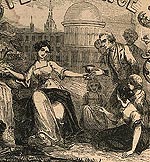
DETAIL: CLICK
IMAGE TO ENLARGE
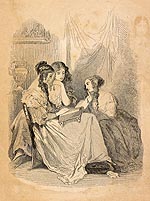
CLICK IMAGE TO ENLARGE
Those women who embarked on literary careers played an equally influential role in civil society, both as writers and as editors. Enlarged economic opportunity, increasing literacy, and social mobility brought thousands of women into an expanding world of print in the decades between the American Revolution and the Civil War. Beginning in the last decade of the eighteenth century, the number of periodicals published in the United States rapidly increased, as did the number of magazines designed specifically for a female readership.* A full decade before Stowe began publishing in Godey's Lady's Book in the 1840s, more than one hundred such magazines were competing for readers. In common with Stowe, many other writers who published in periodicals were edited by another woman. By the last decade before the Civil War, more than one hundred and fifty women were editing a wide variety of magazines in all of the nation's regions, including the South and the West. Thousands of other women entered the world of print with essays, novels, biographies, and histories. In an antebellum America in which authorship was becoming a profession, women writers and their publishers shared in the profits of an expansive print culture. Technological innovations in the manufacture of paper, in the mechanization of presses, and in the casting and setting of type propelled a shift from relative scarcity to abundance in books, periodicals, and newspapers, all of which were vehicles for the publication of women's writings. The dramatic improvements in transportation and the emergence of large publishing houses in Philadelphia, New York, and Boston made it possible to distribute those writings throughout the United States. In the profession of authorship, as in participation in reform movements, women were taking their place in the making of public opinion.*
Relatively few women would have an impact equal to Stowe's, although as she began the serial that would be published as Uncle Tom's Cabin, she had little idea that the three or four sketches she had promised Gamaliel Bailey would become a novel. On June 5, 1851, Stowe's initial installment appeared in the National Era. Nearly ten months later, John P. Jewett published the novel on March 20, 1852, twelve days before the last installment appeared in Bailey's antislavery weekly. The first edition of Uncle Tom's Cabin was offered in three styles of binding-cloth full gilt, cloth, and paper wrapper at $2.00, $1.50, and $1.00 respectively. Sales were immediate. They were also phenomenal. Within ten days of publication, the initial printing of five thousand copies had been sold and a second five thousand had appeared. By the middle of May, fifty thousand copies had been purchased. Five months later, Jewett announced that more than one hundred twenty thousand copies were now in the hands of readers. When Stowe had written to Bailey about the sketches that became the enormously successful novel, she had told him that she would be painting the "lights and shadows of the 'patriarchal institution.'" She would limn "the best side of the thing, and something faintly approaching the worst." That Stowe conceived herself as a "painter" is telling. "There is no arguing with pictures, and everybody is impressed by them, whether they mean to be or not," she told Bailey. Perhaps. But it is the painterly technique in which Stowe worked that contributed most decisively to the novel's success. Limning the novel's broadest strokes in the imperatives of sentiment and sentimentality, Stowe appealed to the hearts of her readers.*
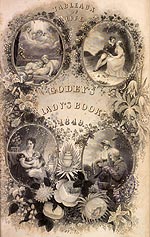
CLICK IMAGE TO ENLARGE
Nowhere is the language of the heart deployed more effectively than in the ninth chapter of Uncle Tom's Cabin. There an idealized portrayal of the independent householder's family is set alongside the plight of a slave mother and her child. Returning from a session of Ohio's legislature, Senator John Bird enters the family's "cosey parlor" and removes his boots "preparatory to inserting his feet in a pair of new handsome slippers, which his wife had been working for him while away." Mary Bird prepares her husband's tea, "ever and anon mingling admonitory remarks to a number of frolicsome juveniles." This "picture," which foregrounds an orderly and secure home, stands in sharp contrast to the predicament of the slave mother, who arrives at the Birds. Here is the counterpoint that Stowe painted for her readers: "with garments torn and frozen, with one shoe gone, and the stocking torn away from the cut and bleeding foot, [Eliza] was laid back in a deadly swoon upon two chairs." After opening her eyes, she has no concern for herself. The mother's immediate thought instead is her child. "O my Harry! Have they got him?" she cries.*
The same premises that inform Stowe's "pictures" of these two families demarcate the boundaries articulated in antebellum domestic discourse. Mary Bird's "husband and children were her entire world," Stowe tells her readers and, as she adds pointedly, "in these she ruled more by entreaty and persuasion than by command and argument." Hers is a world that appears to be distinctly separate from John's, and only rarely does she trouble "her head with what was going on in the house of the state, very wisely considering that she had enough to do to mind her own." However, the passage of legislation that required residents of Ohio to aid in the search for fugitive slaves precipitates the crisis that forces Mary to cross the boundaries separating the domains of wife and husband. Astonished that such a "shameful, wicked, abominable law" could be passed, Mary tells John that the legal and political authority he holds has no legitimacy before the moral evil entailed in this complicity with slavery. "I'll break it, for one, the first time I get a chance; and I hope I shall have a chance, I do!" she declares.*
During the ensuing exchange between wife and husband, Stowe employs familiar premises that differentiate women's cognitive faculties from men's. Aligning Mary with the heart and John with the head, Stowe also aligns herself with the heart as the superior guide. John tells Mary that her "feelings" are perfectly fine. But, as he adds pointedly, "we mustn't suffer our feelings to run away with our judgment." Sympathy,which her husband consigns to the "private" world of the home, must be set aside before the state's "public interests." Mary, who will have no truck with this abstract and impersonal defense of politically and legally constituted authority, forces her husband to confront the issue on the more palpable terms that are governed by sentiment, "I put it to you, John,--would you turn away a poor, shivering, hungry creature from your door, because he was a runaway?" The husband's position is all the weaker because John rests his defense on the secular grounds alone. When he asks, "my dear, let me reason with you," Mary tells him that it is "reasoning" is being used to cloak an obvious evil--"it's the way you political folks have of coming round and round a plain right thing." There is a higher authority that insists on the primacy of feeling right. "I can read my Bible," Mary tells her husband, and "there I see I must feed the hungry, clothe the naked, and comfort the desolate." That Bible and the feeling sanctified in its pages, "I mean to follow."*
Throughout this matrimonial debate, Stowe is intent on persuading readers that womanhood entails a power different from that wielded by men. Stated succinctly, it is indirect agency, the "entreaty and persuasion" that Stowe has already ascribed to Mary. With the "affections" as her guide and Scripture as her text, Mary wields an influence that induces John to open his heart. As Mary tells him, "your heart is better than your head," at least in this matter. Eliza must go beyond entreaty and persuasion. Yet she too acts on the principles embedded in the heart and reinforced by the Bible. Having fled with her son, Eliza tells the Birds, "The Lord helped me; nobody knows how much the Lord can help 'em, till they try." Both Mary and Eliza, who rely on the "affections" as their guide, are brought into conflict with male authority, be it clothed in a law remanding slaves to their masters or a system shattering the ties of family. In insisting that human beings cannot be treated as property, these women deny the very premise that undergirded slavery. They are subversives and as such they are ready to commit acts of civil disobedience.*
What, then, were the lessons Stowe expected women like herself to learn from this pivotal chapter in the novel? Having made slavery's greatest sin the separation of a mother from her child, Stowe concluded Uncle Tom's Cabin with an impassioned plea to those mothers whose race privilege secured them against this fate. "You who have learned, by the cradles of your own children, to love and feel for all mankind," were obligated to intervene against the injustices of slavery. Two years later, Stowe provided them with a strategy. The occasion was yet another congressional debate on slavery. Published in the evangelical weekly, The Independent, Stowe's "Appeal to the Women of the Free States" spoke in a litany of questions to the most recent issue: "Are we willing to receive slavery into the free States and territories of the Union? Shall the whole power of these United States go into the hands of slavery?" Obviously not, yet such was possible because the newly proposed legislation entailed repeal of the Missouri Compromise, which had prohibited slavery north of Missouri's southern border. Charging that there was not a "mother among us all, who clasps her child to her breast, who could ever be made to feel it right that that child should be slave," Stowe continued to appeal to a bond that supposedly transcended race and class. The "Appeal" was also the site at which Stowe made explicit the fundamental difference between women and men. The latter's perceptions might be obscured by "ambition and the love of political power," she told her readers. Women were not so tempted. Endowed with a "knowledge, in those holier feelings, which are peculiar to womanhood," they felt more deeply the responsibility to protect the family. Of course, Stowe had directed her "Appeal" to those excluded from participation in the political processes that elected officials and debated legislation. Denied the exercise of direct political power, a woman was still able to "give her influence on the right side," Stowe insisted. Exercising that influence included petitioning Congress, which brought women already involved in civil society into direct contact with politically constituted authority. Like so much else in her experience and her prose, Stowe's perception of slavery and antislavery was filtered through the prism of women's responsibilities to those constituting her family. That family now included the nation state. Therein lay the power of a discourse of domesticity that enabled women to take the home into the world.*
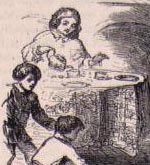
DETAIL: CLICK
IMAGE TO ENLARGE
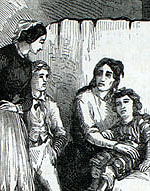
DETAIL: CLICK
IMAGE TO ENLARGE